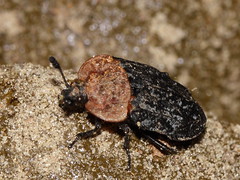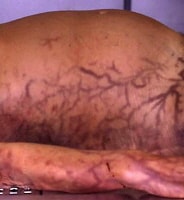| (Photo credit: Wikipedia) |
Before we get started here are some abbreviations:
GSW= Gunshot Wound
MVA = Motor Vehicle Accident
ME = Medical Examiner
COD = Cause of Death
OD = Overdose to the abbreviations
MI = Myocardial Infarction (Heart Attack
OD = Overdose to the abbreviations
MI = Myocardial Infarction (Heart Attack
Good morning Doctor. I'd shake your hand, but uhm, you just got out of you lab and eww. You have one of those jobs that makes me very much appreciate that we all have different personalities and roles to play in society. Mine is to ask invasive questions and yours is to be invasive - for good reason.
Can you take through your background a little?
I got my undergraduate degree from Harvard in 1991, and then I went to Medical School at UCLA. I graduated in 1996, having taken a one year "post-sophomore fellowship" in pathology. Then I did six months of a residency in general surgery before dropping out and switching to pathology. Four years later I was a board-certified pathologist and went to train at the New York City Medical Examiner's Office. Working Stiff: Two years, 262 Bodies & the Making of a Medical Examiner (Scribner) published in August 2014 is my memoir of that training. After that I worked for one year at the Santa Clara Office of the Medical Examiner/Coroner, nine years at the San Francisco Office of the Chief Medical Examiner and one year at the Alameda County Coroner's Office. As a forensic pathologist, I do autopsies to figure out the cause and manner of death in sudden, unexpected or violent deaths.
Fiona -
Can you walk me through the process? For example: What information are you given along with the body? What is your role
in the process? How is the body packaged and then what do you do?
Dr. Melinek -
When I come in to work every morning there is a list of cases for me and my colleagues to look at. It is called the "Daily Case List," and it summarizes each death that was brought in over the last 24 hours, or if it is a Monday, over the weekend. Each case typically has a case number (2014-00123) and a name (Last name, First name) and then a brief description of the circumstances surrounding the death. It would say something like this:
As for tox deaths, they usually have no interesting physical findings at all, and there is a dipstick you can use in the morgue on urine or pericardial fluid to see if the tox will be positive, but few morgues use it. It has good sensitivity but poor specificity - if I recall correctly. Usually we have a "negative autopsy" (meaning no significant anatomic cause of death) and we wait 2-4 weeks for the tox to come back.
Fiona -
You've mentioned your book Working Stiff - it's a fascinating subject.
Dr. Melinek -
Working Stiff has a very matter-of-fact description of the autopsy process. I don't paint a pretty picture or use euphemisms. I tell it like it is. I describe how a forensic autopsy is done from the external incisions all the way down to how each organ is examined, but I focus on the interesting details, and it doesn't read like a how-to-manual. It's meant for the lay public - but I wouldn't recommend reading it while you are eating dinner if you are squeamish.
Dr. Melinek -
When I come in to work every morning there is a list of cases for me and my colleagues to look at. It is called the "Daily Case List," and it summarizes each death that was brought in over the last 24 hours, or if it is a Monday, over the weekend. Each case typically has a case number (2014-00123) and a name (Last name, First name) and then a brief description of the circumstances surrounding the death. It would say something like this:
A 53 year old woman found deceased in a neighbor's garage holding a power tool. She was found with the tool still in her hands, prone on the floor. She was found by the neighbor who minutes earlier had given her the drill, which she was borrowing, and then briefly left her in the garage to answer a phone call. When the neighbor returned he found her unresponsive. Paramedics were called and declared death...
There usually is some notation about the medical history, the condition and appearance of the body and whether there were drugs present. Every case gets a similar write-up though some are briefer than others, especially if there is no medical history, the body is just "found" by a stranger in the field, or there is a medical chart to go through, and then the investigators will briefly summarize what's in the chart by saying something like "he died of medical complications 3 months after the arrest..."
We then go through the list and decide which cases to autopsy and which can get an external examination. Then we go into the morgue to take a look at the cases we assigned ourselves and at the bodies. Autopsies start around 9 am and end around 12 noon.
The body arrives in a "pouch" or "body bag" and is removed by technicians. It is already stripped and naked on the autopsy table when we get in UNLESS the case is a homicide - then the clothing and hand bags and evidence are usually still on the body for us to observe and document.
Fiona -
How long is each autopsy?
We then go through the list and decide which cases to autopsy and which can get an external examination. Then we go into the morgue to take a look at the cases we assigned ourselves and at the bodies. Autopsies start around 9 am and end around 12 noon.
The body arrives in a "pouch" or "body bag" and is removed by technicians. It is already stripped and naked on the autopsy table when we get in UNLESS the case is a homicide - then the clothing and hand bags and evidence are usually still on the body for us to observe and document.
Fiona -
How long is each autopsy?
Dr. Melinek -
It depends. Average autopsy (natural, OD, MVA) can take about 45 minutes from when I start the external examination to when I leave the table for the techs to close up the body. More complex cases (injured babies, multiple gunshot wound homicides with intersecting paths) can take hours, even be split up over multiple days. My longest one took me 3 days to complete working 3-4 hours each day on the autopsy dissection, X-ray radiography and documentation alone (not including the dictation, which I often do later from my notes).
Fiona -
Not all bodies are referred to you correct? For example a male who takes nitroglycerin and dies of a heart attack would skip you and go right to the funeral home?
Dr. Melinek -
Fiona -
Not all bodies are referred to you correct? For example a male who takes nitroglycerin and dies of a heart attack would skip you and go right to the funeral home?
Dr. Melinek -
It depends. Cases are referred to the Coroner or Medical Examiner when they are sudden and unexpected. So if the guy who took nitroglycerin and died of a heart attack did so at a bank during a bank robbery, we would be concerned that the MI was a result of the stress of the robbery, and he would come to us. Cases that die in the hospital or natural disease and a doctor from the hospital is willing to sign the death certificate don't get referred to us, unless there was trauma or the family called and had evidence of foul play - e.g. they said the death wasn't natural.
Fiona -
How do you determine what kinds of exams to do? What exams are available to you? Does this depend on location - for example would a small town send a body to a larger city for any reason? And the final question in this stream of thought, how long do the various tests take to get back the needed information for example toxicology reports?
Dr. Melinek -
The examination is dependent on the information we get about a case. So for instance, an MVA, that would be referred to the ME or Coroner. The cases are usually done locally, but it depends on the jurisdiction. So for your authors, they need to decide if the place they are writing about is real or fictional. If it is real, I suggest they Google the Coroner's office for that county and find out from the Coroner's investigator what would happen to the body. I have fielded calls like this from writers before at my jurisdiction. Most folks are happy to help. They want writers to get it right!
The amount of time it takes to get the results back from an autopsy depends on a lot of factors: the complexity of the case, if there is toxicology, or if there is additional investigation needed. Most cases are closed in 1 -3 months. I've had some take 1 year. Tox results come back in 2-4 weeks in most cases.
Fiona -
When you are watching TV/movies or reading books - what about their portrayal of a ME makes you want to pull your hair out - what do you want writers to get right?
Dr. Melinek -
I actually wrote a blog post about this. It's called 7 CSI Fails. Writers often get the details right (because they looked them up in books or journals), but then they put it together all wrong. Let me give you an example. There was an episode of CSI where the pathologist identified that a person was shot with a meat bullet because there are different types of maggots that prey on beef than on humans. Now, I'm not an entomologist. There is *no way* I would be able to distinguish a beef-eating maggot from a human-flesh-eating-maggot. In fact, I believe that you can't tell them apart until they mature past the larval stage - but that is another matter entirely. Writers usually get the details of how a poison works, but then they have the detective doing something dangerous or foolish that is out of proper protocol and would never happen - like break chain of custody, or have it tested by a "friend" instead of the official lab - stuff like that.
Fiona -
When you see a body, can you guess right off the cause of death for example, anaphylaxis when eating shrimp, pink skin tone/ organs with poisoning/ white substance about the nose and signs of respiratory failure. Could you/would you see these things without a toxicology report and give the cops and educated guess to work off of before the official report is out - would it make a difference if they were good friends? (Hypothetically, of course)
Dr. Melinek -
First of all, let me tackle the friends thing. Then I will tackle the knowing the COD (Cause of death) afterwards.
Fiona -
How do you determine what kinds of exams to do? What exams are available to you? Does this depend on location - for example would a small town send a body to a larger city for any reason? And the final question in this stream of thought, how long do the various tests take to get back the needed information for example toxicology reports?
Dr. Melinek -
The examination is dependent on the information we get about a case. So for instance, an MVA, that would be referred to the ME or Coroner. The cases are usually done locally, but it depends on the jurisdiction. So for your authors, they need to decide if the place they are writing about is real or fictional. If it is real, I suggest they Google the Coroner's office for that county and find out from the Coroner's investigator what would happen to the body. I have fielded calls like this from writers before at my jurisdiction. Most folks are happy to help. They want writers to get it right!
The amount of time it takes to get the results back from an autopsy depends on a lot of factors: the complexity of the case, if there is toxicology, or if there is additional investigation needed. Most cases are closed in 1 -3 months. I've had some take 1 year. Tox results come back in 2-4 weeks in most cases.
Fiona -
When you are watching TV/movies or reading books - what about their portrayal of a ME makes you want to pull your hair out - what do you want writers to get right?
Dr. Melinek -
I actually wrote a blog post about this. It's called 7 CSI Fails. Writers often get the details right (because they looked them up in books or journals), but then they put it together all wrong. Let me give you an example. There was an episode of CSI where the pathologist identified that a person was shot with a meat bullet because there are different types of maggots that prey on beef than on humans. Now, I'm not an entomologist. There is *no way* I would be able to distinguish a beef-eating maggot from a human-flesh-eating-maggot. In fact, I believe that you can't tell them apart until they mature past the larval stage - but that is another matter entirely. Writers usually get the details of how a poison works, but then they have the detective doing something dangerous or foolish that is out of proper protocol and would never happen - like break chain of custody, or have it tested by a "friend" instead of the official lab - stuff like that.
Fiona -
When you see a body, can you guess right off the cause of death for example, anaphylaxis when eating shrimp, pink skin tone/ organs with poisoning/ white substance about the nose and signs of respiratory failure. Could you/would you see these things without a toxicology report and give the cops and educated guess to work off of before the official report is out - would it make a difference if they were good friends? (Hypothetically, of course)
Dr. Melinek -
First of all, let me tackle the friends thing. Then I will tackle the knowing the COD (Cause of death) afterwards.
You don't get too close to police officers in this field. There are many that I love working with and have years-long collegial relationships with but in general it is professional suicide to date or even fraternize with cops after hours. I have gone to many of their retirement parties and have had lunch with a few of them while we discussed cases (working lunches/coffee) but few ME's (unless in a really rural area, where there is no one to hang out with) will have chummy relationships with cops. There is a simple reason: objectivity. As I discuss in Working Stiff, sometimes my conclusions and the police officers are at cross purposes. I think the case is a homicide, but he thinks it's a simple accident and doesn't want to investigate further. My determination (homicide) complicates his life considerably...
Now, there are some things you can tell from the outside of the body to give the cops something to work with. Here's an example:
Now, there are some things you can tell from the outside of the body to give the cops something to work with. Here's an example:
The roommate says that he came home from work and found the guy dead with the crack pipe next to him, but there is a furrow around the neck and the crack pipe is nestled in the hands with the guy sitting on the couch, and yet the guy's left hand is "defying gravity" while all the lividity is on the body's left side, indicating that the body was moved *after* rigidity ad lividity developed. The roommate most likely strangled him and then sat him up to try to make it look like a drug OD.
Foam in the mouth is non-specific: it could be heart failure, heroin OD, or drowning... among other things. Usually it's a constellation of findings that make you suspicious something is up - not just one thing.
As for tox deaths, they usually have no interesting physical findings at all, and there is a dipstick you can use in the morgue on urine or pericardial fluid to see if the tox will be positive, but few morgues use it. It has good sensitivity but poor specificity - if I recall correctly. Usually we have a "negative autopsy" (meaning no significant anatomic cause of death) and we wait 2-4 weeks for the tox to come back.
Fiona -
You've mentioned your book Working Stiff - it's a fascinating subject.
1) For our squeamish readers - how graphic is it?
2) Can you give us a general description
3) What could a writer learn from reading your book that would
make their prose better?
Dr. Melinek -
Working Stiff has a very matter-of-fact description of the autopsy process. I don't paint a pretty picture or use euphemisms. I tell it like it is. I describe how a forensic autopsy is done from the external incisions all the way down to how each organ is examined, but I focus on the interesting details, and it doesn't read like a how-to-manual. It's meant for the lay public - but I wouldn't recommend reading it while you are eating dinner if you are squeamish.
General description: You make a Y incision from the shoulders to the pubic bone, then peel back the skin and take out the organs one by one, weight them and slice them in certain ways to look for signs of disease or injury in each one. Some pathologists dictate during this time to overheard microphones. I take notes or have my assistant take notes and I dictate later.
Anyone who reads Working Stiff, will get a much better understanding of what a forensic pathologist does, and how we investigate deaths. They will also learn along with me, as I wrote the journal the book was based on while I was training. It's not just about getting the right terminology - it's about understanding the mindset of a doctor/detective.
In WORKING STIFF, readers learn:
* Real-life crime solving, and the truth behind shows like CSI and
Law and Order
* On-the-job training as a detective-doctor in New York
* The harrowing process of identifying the victims of 9/11 and
American Airlines flight 587
* Judy’s role in grief support, and in providing closure to families
after unforeseen deaths
* The quest for a work/life balance, shuttling between the living and
the dead—conducting an autopsy while pregnant, feeling a new
human life growing inside you while exploring the body of
another life just extinguished
* T.J.’s role of stay-at-home dad—and the sacrifices we make to
support the ones we love
* How the suicide of Judy’s father when she was young informs her
job as a medical examiner
* True tales—stranger than fiction—from the morgue
* Real-life crime solving, and the truth behind shows like CSI and
Law and Order
* On-the-job training as a detective-doctor in New York
* The harrowing process of identifying the victims of 9/11 and
American Airlines flight 587
* Judy’s role in grief support, and in providing closure to families
after unforeseen deaths
* The quest for a work/life balance, shuttling between the living and
the dead—conducting an autopsy while pregnant, feeling a new
human life growing inside you while exploring the body of
another life just extinguished
* T.J.’s role of stay-at-home dad—and the sacrifices we make to
support the ones we love
* How the suicide of Judy’s father when she was young informs her
job as a medical examiner
* True tales—stranger than fiction—from the morgue
I wrote Working Stiff with my husband. When I was training, I took notes and at the end of my fellowship I structured the book into the case-based structure it has now. I handed the notes off to him, and as an English major, who worked in the film industry as a "script-doctor" for years, he took the notes and structure and created the book. We e-mailed it back and forth between us chapter by chapter for over a year, writing, re-writing and polishing. This was really a combined labor of love.
We really enjoy working together as a collaborative team. We are now working on writing a forensic detective fiction/noir series based in San Francisco, and we are having a lot of fun doing it. We both bring our respective skill sets to each project: me as a doctor and researcher, he as a writer. Medical school does horrors for your writing: I tend to write in the passive voice, and ramble on. He writes so much better than I do. We couldn't do what we do without the other.
Fiona -
Here at ThrillWriting we have a traditional question - please tell me the story behind your favorite scar - and barring a scar can you tell us a harrowing story that you survived?
Dr. Melinek -
Fiona -
Here at ThrillWriting we have a traditional question - please tell me the story behind your favorite scar - and barring a scar can you tell us a harrowing story that you survived?
Dr. Melinek -
I have a stigmata: a 1/2 inch scar on my left hand, which I got when I was 10 years old at camp. I was climbing on a rusty windowpane that was discarded in the woods by the campground parking lot. Why anyone would dump and rusty windowpane in a place where children are dropped off is beyond me. The pane was huge: built for an industrial-type window, and it was folded on itself like a jungle gym. Others were climbing on it as well. Well, when the bell rang for the first camp session to start, the other kids ran off and I tried to climb down by myself, and then I fell, impaling my left palm on a rusty spike from the pane. It went in about 1/2 inch. I pulled my hand off, started crying, but then realized that there was no one around to help me. So I stopped crying, walked to the nurses' station, and I realized that things were serious when they let me go ahead of the kid who was bright red, covered head to toe in poison oak. They took me to the hospital where I had to get stitches.
Fiona -
Fiona -
Thank you so much for your time and expertise. You can contact Dr. Melinek at:
Twitter handles are: @drjudymelinek and @TJMitchellWS
They also have the #DrWorkingStiff
See how this article influenced my plot lines in my novella MINE and my novel CHAOS IS COME AGAIN.


























